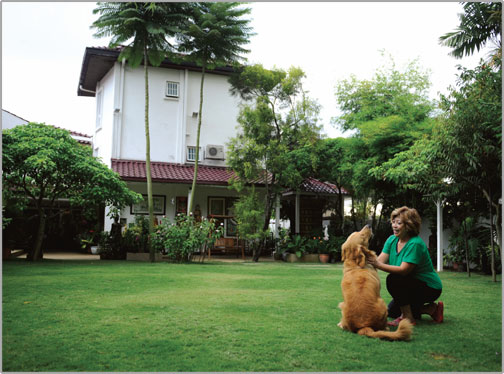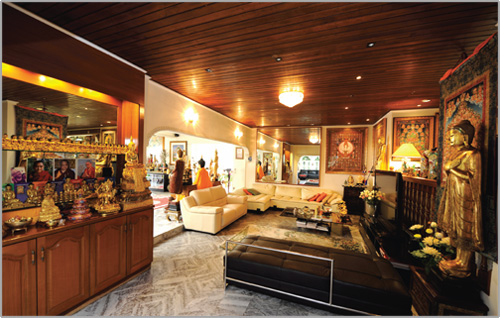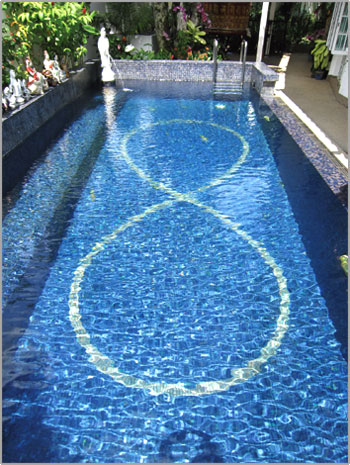|
 Life in the feng shui lane Life in the feng shui lane
by Kee Hua Chee
The Star
Saturday, 16 January 2010
Ever wondered what the home of a successful and famous feng shui master looks like? Wonder no more. Lillian Too has published the book Living With Good Feng Shui, featuring 365 photos of her home.
When Lillian Too speaks on feng shui, people listen. And they are willing to pay for it, sometimes as much as US$10,000 (RM33,480).
She also entered history books by being the first woman to run a Malaysian public-listed company, Hong Leong Credit, and, in 1982, she became the first woman in Asia to be CEO of Grindlays Dao Heng Bank, the fifth largest in Hong Kong. Dining with then Hong Kong Governor Lord Chris Patten was the norm and she was feted in the highest financial circles.

Lillian Too with Google, a golden retriever, in the Brightness Hall (lawn) of her two homes.
However, she left for Kuala Lumpur in 1998 to be a full-time mother to her only child Jennifer.
“I am comfortable but not a billionaire! Money is important to me because it gives me the freedom to donate to charities.’’
Too recalls how when she first got MPH to distribute her feng shui books in 1997, the book chain did not know where to put them.
“It was a toss up between Chinese Culture and Interior Design! I vowed to create a new section just on feng shui in every bookshop!” beams the indefatigable author.
Today, after over 100 books, she is going stronger than ever as a feng shui writer. Her books have been translated into 31 languages including Lithuanian, Latvian and Mongolian and sold over 10 million copies in 38 countries.
“How many ways are there to write on feng shui without repeating yourself? After a while, readers expect something different,” Too says.
 The living hall is lavishly decorated with Buddhas and thangkas.
The living hall is lavishly decorated with Buddhas and thangkas.
Hence the book Living With Good Feng Shui.
“Previously I taught how to apply feng shui principles. Now I am showing how I did it to my own home in Kuala Lumpur,” smiles Grandmaster Too, a title bestowed on her last December by the Feng Shui Association of Singapore.
Last week, she was awarded Personality of the Year by the Brand Laureate Asia Pacific Brands Foundation. On Jan 10, she launched the book at KL Convention Centre with a lion, dragon and phoenix dance.
“This book is autobiographical and can be narcissistic so I had to tread carefully,” says Too.
“I want it to benefit everyone and show how anyone can be as successful as me using feng shui.
“When my husband built this house in 1976, our budget could accommodate exactly 2,150sq ft! I decorated it to precise feng shui proportions and it has grown organically over the years, getting bigger as I made more money.
In 2007, I bought my neighbour’s bungalow and merged the two buildings. The land is now 20,000sq ft with a built-up area of 15,000sq ft. To me, this is a veritable mansion. If I can do it, anyone can do it,” Too insists.
She is also introducing the third dimension in feng shui — Spiritual Feng Shui.

A lucky number eight pool.
“Feng Shui works regardless of your religion but you MUST be kind-hearted, sincere and magnanimous. I am a Tibetan Buddhist so I decorate my house in a Buddhist and Taoist theme. But you can do it your own way based on your beliefs.’’
Family affair
Initially, Too was hesitant to feature her home for security reasons.
“My husband also asked if it wasn’t an invasion of privacy as everyone could now see our home in detail. We thought long and hard but decided to go ahead.
Conveniently, Chris Yeo, her architect son-in-law, happens to be a professional photographer and volunteered his services, while daughter Jennifer, editor of Feng Shui World magazine, edited the book.
Her bedroom, toilet, meditation hall a. k. a. private temple and visiting monks’ quarters are no-go zones.
“Only the public areas are shown,’’ says Too.
“My toilets are small and functional as I don’t believe in lavish trappings like gold taps and basins which can drain away your wealth.”
Too says she has lost count of the number of Buddhas, Kuan Yins, Kwan Kungs and various Tibetan deities that occupy her house.
There is always room for one more statue — this seems to be her mantra!
“Why settle for one great Buddha statue when you can have 200?” she giggles.
“To me, when space looks bare, it suggests poverty, lack of creativity and a certain emptiness. I love my house to look full, have many beautiful objects to engage the senses and to feel prosperous. Not cluttered but abundant! I fill my house with things I love. Every table, shelf, display cabinet and corner tells a story.
“I love bright, joyful colours which create happy vibes. I love coloured bulbs everywhere. I have a phobia for greys, off-whites and off-blacks. They are yin, depressive and oppressive.
“I love houses that breathe life and are filled with colour, laughter, music and the sound of children or pets running around.
“Never mind if certain things don’t match. What is important is the sense of yang energy. The characters of the owners, their eccentricities and passions, must be stamped all over the home. Then only can a house take on life and be auspicious for its occupants!”
In the same breath, she says, “Some think I have over-decorated but I never feel this way. I like being surrounded by many things.’’
Once she visited a friend’s new dig all done in the latest contemporary style.
“Grey marble, black leather furniture, black cabinets, white walls etc. Their home looked sleek, expensive and designer but oh, so cold, stark and lifeless!
“I was not surprised to learn the hip, stylish couple split three months after moving in. There were poison arrows everywhere and the furniture looked sad, lonely and uncomfortable. There was yin formation written all over it.”
Still, her house is not perfect, not having a mountain behind nor a river or lake in front.
“It has no fantastic views so I built a high wall, planted trees and blocked out the roof views, effectively creating my own landscape. Now I enjoy looking up at the great expanse of sky while the lawn is my Brightness Hall with flowering plants and orchids everywhere.’’
Living with Good Feng Shui, now available at bookstores, costs RM138. |














